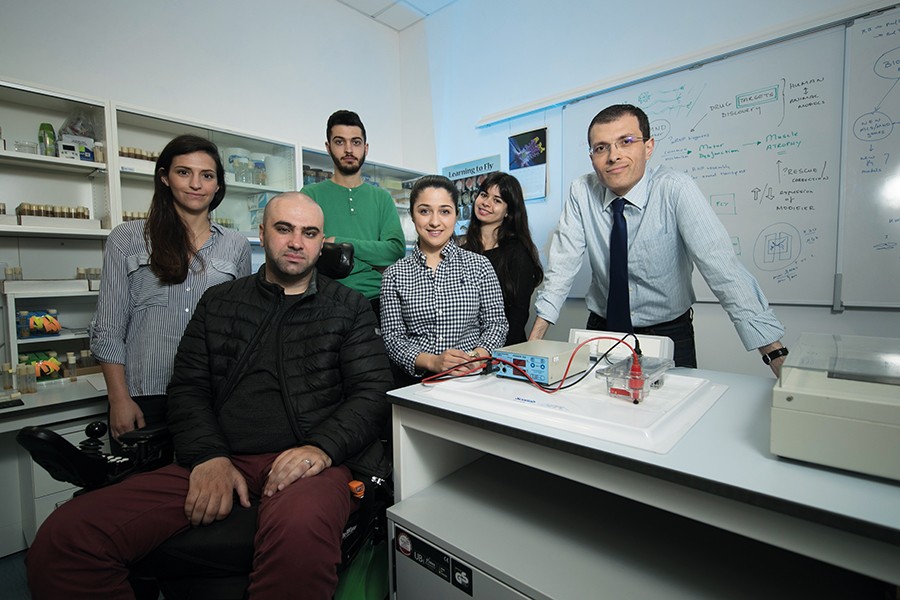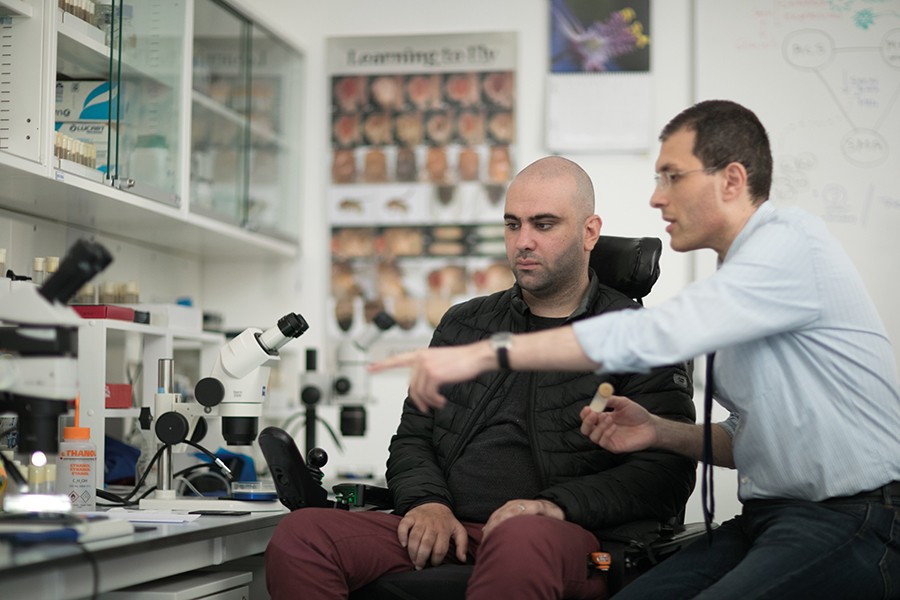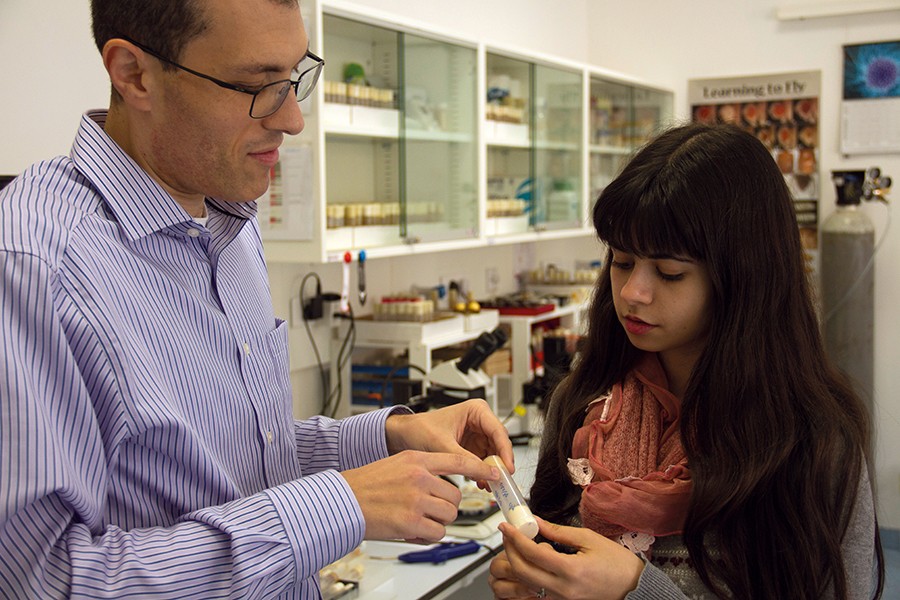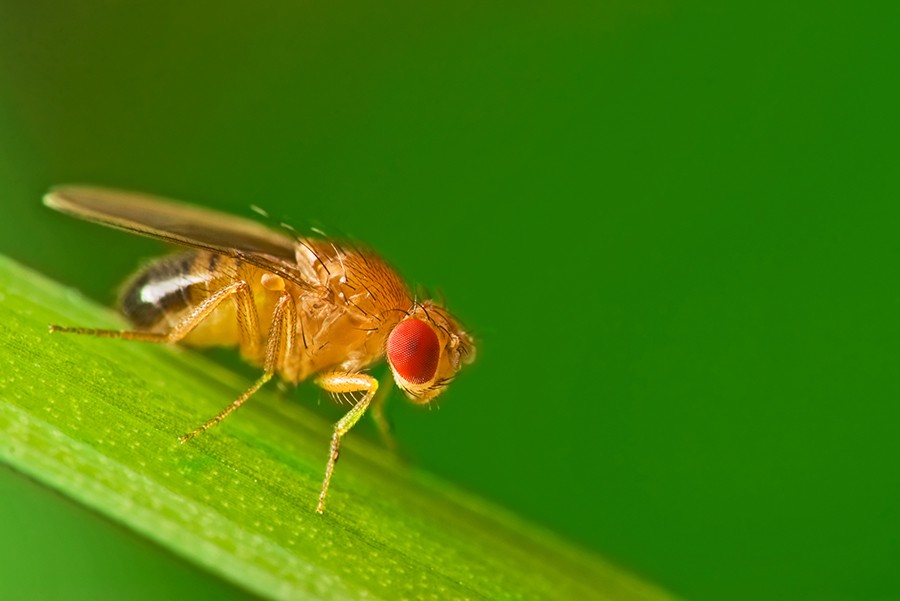The Ice Bucket Challenge shot motor neuron diseases into the limelight in 2014.
But how much did the ice cold water really represent ALS, and what legacy has it left for research into these diseases? Becky Catrin Jones speaks to Dr Ruben Cauchi and Maia Lanfranco to find out more.

The summer of 2014 was memorable for a number of reasons: Germany crushed hosts Brazil at their own FIFA World Cup, the new supposedly-bendy iPhone 6 plus was revealed to an expectant audience, and celebrities and civilians alike (including Malta’s prime minister) joined in with the latest viral craze: dumping buckets of ice-cold water over their heads. Why? The reasoning behind subjecting themselves to the shock of freezing water was to raise awareness of a devastating neuromuscular disease, ALS. That frozen moment of paralysis as the water hits is somewhat similar to the patients’ daily experiences: leaving them with a lack of bodily control or inability to move.
Many dismissed the viral challenge as just another pseudo-charity stunt attracting the ‘slacktivists’ who want to be seen as involved, but with minimum effort. However, the Ice Bucket Challenge was incredibly successful in single-handedly raising the profile of a previously obscure disease, practically overnight. More than 2.4 million videos of the stunt were published on Facebook, and at its peak the Ice Bucket Challenge was the subject of over 70,000 tweets a day. Motor neuron disease (MND), most specifically Amyotrophic Lateral Sclerosis (ALS) was suddenly on everyone’s mind. Here in Malta, the conversation also focused on the research of the ALS/MND Lab headed by Dr Ruben Cauchi. Their pioneering work into motor neuron diseases such as ALS and Spinal Muscular Atrophy (SMA) in children began attracting new attention, investment, and researchers.
The biology of motor neuron disease
Motor neurons make up the nerves that control movement in the body, from lifting a pen or kicking a ball, to basic functions like breathing, blinking, and swallowing. An electrical charge from the brain activates these nerves, exciting the neuron, which in turn tells the muscle to move. During the progression of motor neuron disease, neurons are kept in an active, excited state, which eventually exhausts them. When they wither and die, controlled movement of muscles is lost. This process can eventually lead to difficulties with speaking, swallowing, and breathing, which result in the patient’s premature death.
Diseases that affect motor neurons are usually caused by a mutation in the genes that regulate their action. This typically happens during cell division, when the cell replicates itself by copying its genetic code. When a mistake occurs during this copying phase, the resulting protein will be mutated and it will affect the whole cell’s ability to survive. Zooming in to look at the genetic scale can therefore reveal clues to curing these diseases.
Much of Cauchi’s career, beginning with his days as a Ph.D. student at the University of Oxford, has been focused on researching these diseases. ‘As motor neuron diseases are relatively uncommon, the work I was doing was considered as researching something ‘exotic’,’ Cauchi remembers. During his doctoral project, some of his work revealed that SMA was an entirely genetic disease, brought about by mutations in one single gene. This gene was named the Survival Motor Neuron (SMN) gene and is involved in the cell’s ability to successfully translate genetic information in the form of RNA into the respective protein. This discovery was groundbreaking and is paving the way to develop therapeutics.
ALS, however, is a far more complex disease. Unlike SMA, ALS is not entirely genetic. Environmental factors such as diet, excessive exercise, or alcohol and tobacco use are responsible for 90% of its incidence. Also, mutations in ALS can occur in a number of different genes responsible for encoding a variety of different proteins. As a polygenetic disorder, the combinations of different gene mutations seem never-ending, and it is very likely that these mutations are linked. So, how do you even begin to start studying such a disease?

Look to the flies
Luckily, Cauchi and his lab have a very useful tool up their sleeves. ‘Most people think it strange at first that we use flies to study a human disease,’ he explains. However, the fruit fly (Drosophila) is a smart choice, as it has a well-defined genome which can be easily manipulated. Their rapid breeding rate also means that the results of any mutations can be seen very quickly, making fruit flies perfect for studying genetic disease.
When it comes to researching ALS, the genes that encode parts of the fruit fly’s motor neuron system are very similar to those found in humans; so much so that some drugs seen to work in a fly model of ALS can progress straight to trials on human patients.
These models have already produced some success stories. The identification of the SMN gene would not have been possible without the ability to modify and document genetic changes in Drosophila, and some work has also led to the development of a specific treatment for SMA, named Spinraza. This treatment uses a small region of genetic code, antisense oligonucleotide, to bind the faulty gene and change the way it is expressed. This exciting discovery was approved by the FDA in December 2016 and has since shown much success in clinics across the world.
The search for a treatment
Could such a success story be seen with ALS, considering the complexity of the disease? ‘I don’t think that it would be such a ridiculous idea to suggest that a similar treatment could work for ALS,’ comments Cauchi. Though more difficult to map back to the genetic level, the final changes seen in both diseases are very similar. By employing the same tactics, but targeting a network of genes rather than one singular gene, scientists may be able to adapt this technology. The problem is identifying which mutations to target. Many potential combinations have probably already been studied, but if these do not produce successful results, it is unlikely that anyone will hear of them. ‘The pressure to produce positive results means that negative ones don’t get published, and so other groups will continue to try the same failing methods rather than progressing as a field.’ Another huge problem is the cost of producing and developing these drugs. ‘It can cost €6 billion to bring an ALS drug to market,’ Cauchi explains. The lack of funding combined with the relatively low incidence of the disease often means that large pharmaceutical companies are reluctant to invest time and money into such drugs.
One way to circumvent the cost of developing new drugs is to use those which already exist. The drug edaravone, originally developed as a stroke treatment, has been found to yield benefits in patients with ALS. However, since completing its clinical trials in Japan, edaravone has faced criticism due to its lack of sufficiently solid data. More studies into its long-term side effects are required, and as a result, it has so far only received conditional FDA approval. More worryingly, the mechanism by which the drug is effective in ALS is not well understood. A systematic approach to understanding the genetic causes will be needed to develop a better treatment.
Making it personal
The term ‘personalised medicine’ is used throughout medical biology today, as we begin to understand how treatment outcomes are affected by variation between different people. This is particularly important while studying genetic diseases, and ALS is no exception. ‘I really think personalised medicine will be the revolution in the treatment of motor neuron diseases,’ Cauchi states. To begin, we must gather as much information as possible from patients currently suffering from ALS or other motor neuron diseases, in order to increase our understanding of the causal pathways.
To this end, Cauchi, along with others, has established the Malta ALS/MND BioBank. The aim of this project is to work with patients in Malta, understanding their experiences, symptoms, and progression, as well as collecting blood samples and carrying out other tests when necessary. The genomes of these patients and their family members are being sequenced to piece together the genetic puzzle of the disease. This communication with patients has already benefitted the researchers; once new, unknown mutations are found in patients, they can be translated back into the fly model for further research.

Competing for the limelight
The incidence of ALS and other motor neuron diseases is relatively low, and so the funding available from government is very restricted, with favour going to other better-recognised diseases. Funding for ALS research in Malta is therefore heavily reliant on charities, NGOs, and citizens. But even among these sections of society, how do you compete for funding against big diseases such as cancer and blood disorders that are highly prevalent in Malta, while motor neuron diseases are still fairly unknown?
‘Science communication is increasingly important, and creative methods bring the most impact,’ says Cauchi. ALS awareness surged thanks to the Ice Bucket Challenge, which initially had an unbelievable effect on the numbers of people who had even heard of the disease. The release of The Theory of Everything, a film documenting the life of Professor Stephen Hawking and the impact of motor neuron disease on his career, again did wonders for the awareness of ALS and brought it to the attention of millions globally. Malta has its own champion in the shape of Bjorn Formosa, who has turned his experience with the disease towards positive ends by dedicating his life to raising funding and awareness. Cauchi speaks very highly of him and the relationship they have, as he does with other patients. ‘I would love to have more time for public engagement, however there are so many pressures that come with academia that communication can sometimes be left behind.’
Another positive result of all the ALS publicity and funding is that it is attracting students and enabling them to continue the research of the lab. Maia Lanfranco is a Masters Biochemistry student and was keen to join Cauchi’s lab for deeply personal reasons. ‘It was the immense suffering and eventually death of one of my relatives from this terrible condition which spurred me on to begin researching ALS,’ Lanfranco recalls. ‘What I enjoy about the research is finding creative methods of unravelling the mysterious ways in which ALS works.’ Communicating the research is also just as important for students as it is for later-stage researchers, and it’s a particular passion of Lanfranco’s, who recently coordinated the lab’s contribution at the national festival, Science in the City.
‘The message is always that ALS is curable, but underfunded,’ concludes Cauchi. And so the reliance on public funding is ever important, with one-off events such as the Ice Bucket Challenge being incredibly useful, but unreliable. With more consistent investment into both researching these diseases and keeping up a constant communication channel with citizens as well as patients, it is possible to envision a cure for motor neuron diseases, led by work being done right here in Malta.





Comments are closed for this article!